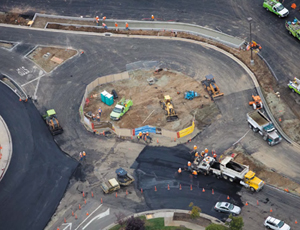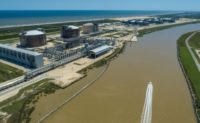
The roundabout, a circular intersection in which traffic flows through from incoming streets in one direction around a central island, is booming in the U.S.—so much so that some engineering firms see it as a straight-up opportunity.
No traffic lights, no idling pollution or wasted fuel, no head-on or "T-bone" collisions—these are the advantages of what Eugene Russell, director of Kansas State University’s Center for Transportation Research and Training, calls the “greatest transportation infrastructure innovation in the past 100 years.” In less than 20 years, the number of roundabouts in the nation has increased to 2,000 from 200, he says.
Omni-Means Engineers and Planners, Sacramento, Calif., decided to target the roundabout sector as a business development move after president Ross Ainsworth drove through a “gazillion” of them in Europe on a trip 16 years ago. Since then, “roundabout construction has seen rapid expansion,” Ross says. Omni-Means has worked on more than 100 roundabout projects.
Ron Boyle, project manager at Omni-Means, says roundabouts are complicated to design and build but are straightforward when it comes to construction. “Entries, exits, deflections, pedestrian crossings, view angles, approaching traffic—all of these details have to be evaluated before you can design and build a successful roundabout,” he says.
From a construction standpoint, it is easier to build a roundabout from scratch than to convert a traditional two-lane intersection or highway interchange. Grading, construction access and space can become issues. “Roundabouts tend to be a little bigger than a two-lane intersection,” Ainsworth says. “With converting an intersection, you do have issues with utilities that usually have to be relocated. If the project is designed properly, however, construction is easy.”
Further, there’s little to no maintenance. “With traffic lights, there’s ongoing maintenance and engineering services that have to be performed every few years, if not every year,” says Jim Brainerd, mayor of Carmel, Ind., a municipality that is acknowledged as a national leader in implementing roundabouts. Carmel is in the home stretch of installing almost 100. ”A roundabout is always cheaper,” Brainerd says.
Modifying a highway interchange by reconstructing an overpass or an underpass can cost about $60 million, Boyle says, adding that Omni-Means can design a roundabout alternative for about $6 million. “They’re usually about 50% to 75% cheaper than building a traditional interchange,” Boyle says.
Critics of roundabouts claim they take up more space and are more expensive and more confusing than traditional intersections. However, drivers warm up to them very quickly, Brainerd counters. In addition to the issue of idling, starting a car from zero “takes a tremendous amount of energy,” he adds. “That saves us millions of gallons of gasoline, and it reduces traffic jams. At rush hour, there’s a little wait, but the other 23 hours of the day there’s no wait.”
Other savings include lower insurance rates for his constituents. "We’ve lowered our injury accident rate by 65%,” Brainerd says. “Usually, insurance companies set rates by zip code, and our rates in Carmel are half of what they are in other places.”
Doug Hecox, a spokesman for the Federal Highway Administration, says continuing outreach and education efforts are needed as more than 60% of drivers hold a negative or very negative view of roundabouts prior to construction. After driving them, however, more than 70% held a “very positive” view, Hecox says.




Post a comment to this article
Report Abusive Comment